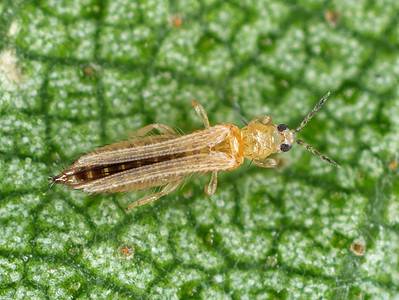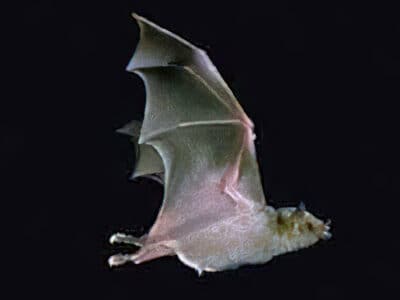Smooth Hammerhead Shark
Sphyrna zygaena
Congregate in large groups during annual migrations
Advertisement
Smooth Hammerhead Shark Scientific Classification
- Kingdom
- Animalia
- Phylum
- Chordata
- Class
- Chondrichthyes
- Order
- Carcharhiniformes
- Family
- Sphyrnidae
- Genus
- Sphyrna
- Scientific Name
- Sphyrna zygaena
Read our Complete Guide to Classification of Animals.
Smooth Hammerhead Shark Conservation Status
Smooth Hammerhead Shark Facts
- Prey
- Fish, squid, crustaceans, rays, and sharks
- Main Prey
- Fish and squid
- Name Of Young
- Pups
- Group Behavior
- Solitary
- Group
- Fun Fact
- Congregate in large groups during annual migrations
- Biggest Threat
- Commercial fishing
- Most Distinctive Feature
- Hammer-shaped head
- Distinctive Feature
- Large, sickle-shaped front dorsal fin
- Other Name(s)
- Common hammerhead shark, round-headed hammerhead
- Gestation Period
- 10-11 months
- Litter Size
- 20-50
- Habitat
- Shallow, temperate waters
- Predators
- Sharks and orcas
- Diet
- Carnivore
- Average Litter Size
- 33
- Lifestyle
- Diurnal
- Solitary
- Group
- Favorite Food
- Fish and squid
- Special Features
- Possess excellent eyesight and a keen sense of smell
- Number Of Species
- 1
- Location
- Worldwide
- Nesting Location
- Shallow bays and estuaries
- Migratory
- 1
View all of the Smooth Hammerhead Shark images!
The second largest hammerhead shark, the smooth hammerhead shark belongs to the hammerhead shark family Sphyrnidae. Like other hammerheads, they have a hammer-shaped head called a cephalofoil that is characteristically smooth, hence their name. They live in temperate waters worldwide and actively feed on prey near the surface using their keen eyes and sense of smell. Smooth hammerheads are considered vulnerable due to overfishing spurred on by demand from the international shark fin trade.
5 Smooth Hammerhead Shark Facts
- Female smooth hammerhead sharks give birth to anywhere from 20 to 50 pups after a gestation period of 10 to 11 months.
- The second largest hammerhead shark species, smooth hammerheads can grow up to 16 feet long and weigh 880 pounds.
- Smooth hammerheads prefer more temperate waters and frequent higher latitudes than other hammerhead sharks.
- While normally solitary, smooth hammerheads occasionally congregate in schools containing hundreds or thousands of sharks during their annual migrations.
- Smooth hammerheads are often caught for their fins which are used in shark fin soup as well as for use in Chinese medicine.
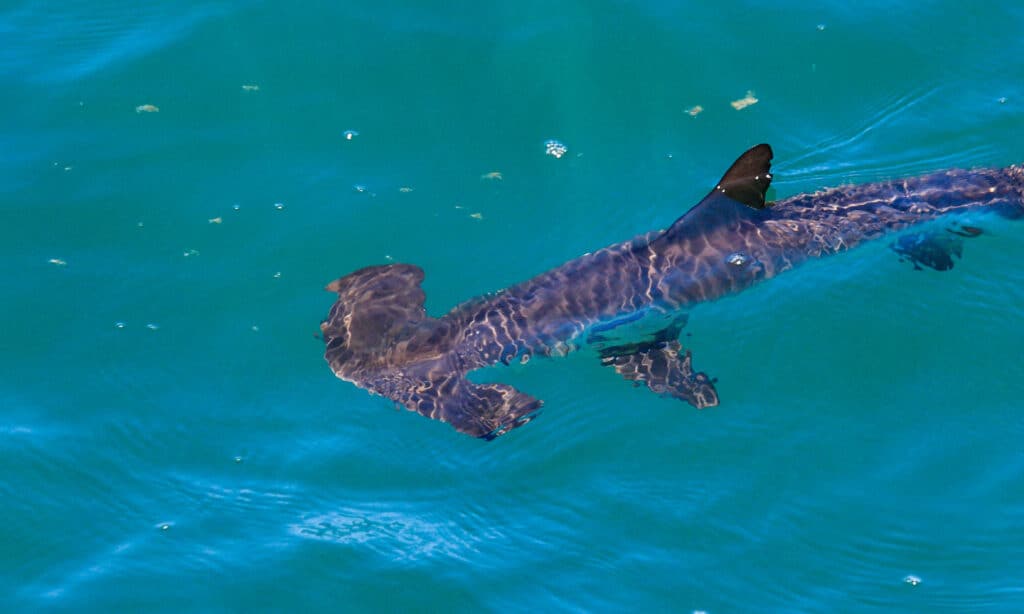
Smooth hammerhead sharks (
Sphyrna zygaena) have a hammer-shaped head that is characteristically smooth.
©iStock.com/Alessandro De Maddalena
Smooth Hammerhead Shark Classification and Scientific name
The smooth hammerhead shark (Sphyrna zygaena) belongs to the hammerhead shark family Sphyrnidae. It gets its name from the distinctive hammerlike shape of its head, which appears flattened and extends laterally away from the body. The smooth head, known as a cephalofoil, lacks the indentations in the front margin common in other hammerhead sharks, hence its name.
Smooth hammerheads belong to the genus Sphyrna, one of the two extant genera in the hammerhead family. They are one of the most basal hammerhead species, and likely one of the closest relatives to ancient hammerheads that first developed large cephalofoils. Their specific epithet zygaena derives from the Greek word zygòn, meaning “yoke.” They also go by other common names including the common hammerhead, round-headed hammerhead, or simply hammerhead. Smooth hammerheads were one of the first hammerheads formally described by naturalists, which explains their common names.
Smooth Hammerhead Shark Appearance
The smooth hammerhead shark is the second largest hammerhead species after the great hammerhead shark. Most specimens measure between 8 and 11.5 feet long, with females typically measuring larger than males. At maximum size, they can measure nearly 16 feet long and weigh up to 880 pounds. Unlike other hammerheads, smooth hammerheads have a curved, smooth cephalofoil that lacks an indentation in the front margin. The cephalofoil appears flat and usually measures between 26% and 29% of the total body length at its widest point.
Smooth hammerheads possess anywhere from 26 to 32 rows of jagged, irregular teeth in the upper jaw and 25 to 30 rows in the lower jaw. The body features two dorsal fins. The first is quite tall and sickle-shaped, while the second is smaller than the first. Smooth hammerheads appear predominantly brownish-gray or olive green in color except for the belly, which is white.
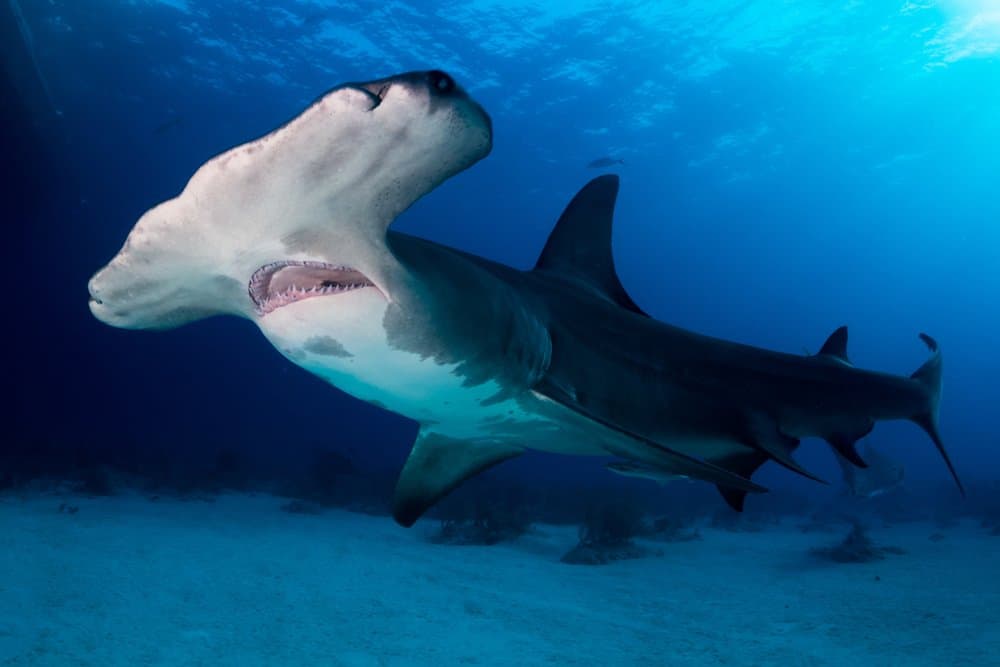
Smooth hammerhead sharks are the second largest hammerhead species after the great hammerhead shark.
©HakBak/Shutterstock.com
Smooth Hammerhead Shark Distribution, Population, and Habitat
You can find smooth hammerhead sharks in temperate waters worldwide and at higher latitudes than other hammerhead species. They occur in the western Atlantic along the east coast of the United States, the Caribbean, Brazil, and Argentina. Meanwhile, you can find them in the eastern Atlantic around North Africa, the Mediterranean, and the southern shores of the United Kingdom and Ireland. As for the western Pacific, they occur in the waters around China, Japan, South Korea, and eastern Russia, and the west coast of the United States and South America in the eastern Pacific. Finally, they also occur around the coast of South Africa, India, Australia, and New Zealand.
Smooth hammerheads typically prefer to stay closer to the surface of the water. While you can find them at depths up to 660 feet, they are most commonly found in waters less than 66 feet deep. They will venture into the open ocean but prefer to hunt and live in coastal bays and estuaries. During the summer months, they migrate to higher latitudes to feed and then move back in the winter to breed and give birth. Although they are mostly solitary, smooth hammerheads will often congregate in large groups containing hundreds or thousands of sharks during their annual migrations.
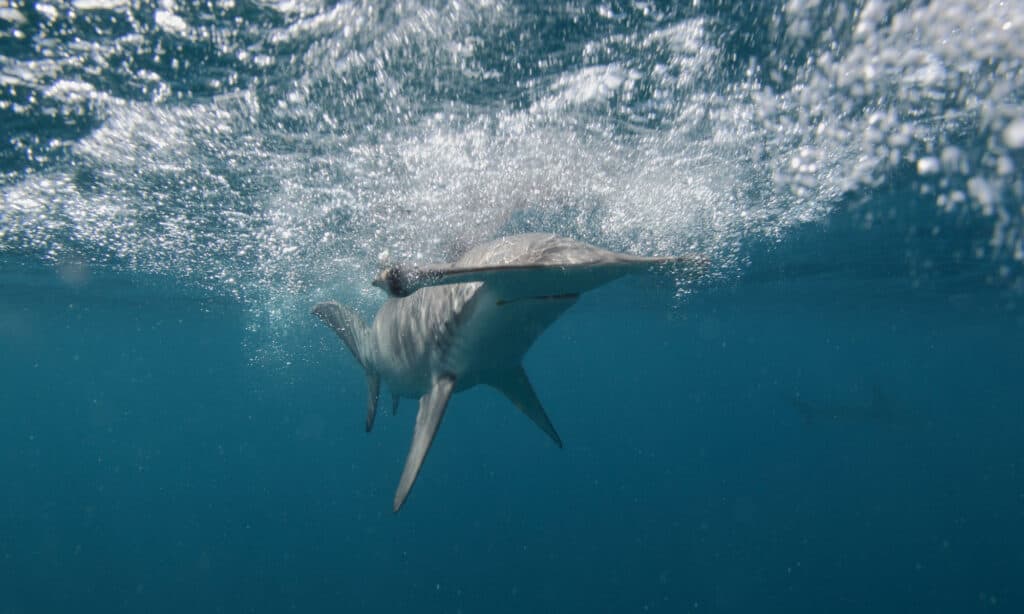
Smooth hammerheads typically prefer to stay closer to the surface of the water.
©Alessandro De Maddalena/Shutterstock.com
Smooth Hammerhead Shark Predators and Prey
Once they reach adulthood, smooth hammerhead sharks have almost no natural predators aside from killer whales. Larger sharks, such as tiger sharks and great white sharks, often prey upon juvenile smooth hammerheads. Aside from predators, several parasites use smooth hammerheads as hosts. These parasites include nematodes like Parascarophis sphyrnae and Contracaecum.
Smooth hammerheads are carnivorous predators that actively hunt for their food. When available, they will also scavenge from fishing lines, which may increase the likelihood of their capture by anglers. They possess excellent eyesight and a keen sense of smell which they rely on to detect prey. Their diet consists mainly of bony fish such as herring, seabass, mackerel, and sardines. In some areas, smooth hammerheads may predominantly prey on stingrays or squid. They also eat limited amounts of crustaceans, such as shrimp and crabs. While rare, smooth hammerheads occasionally prey on dolphins and will also cannibalize other sharks.
Smooth Hammerhead Shark Reproduction and Lifespan
The smooth hammerhead shark is viviparous, which means the young sharks develop inside the body of the parent. On average, females give birth to litters of 20 to 50 pups after a gestation period of 10 to 11 months. They typically give birth in shallow coastal areas no more than 33 feet deep. Birthing times can vary depending on the location but typically occur during winter between January and March. Instead of measuring maturity by age, hammerhead sharks are considered mature once they reach a certain size. For females, this occurs at around 8.9 feet long, while males mature somewhere around 6.9 to 8.2 feet long. They can live up to 20 years or longer, given the right conditions.

At maximum size, smooth hammerhead sharks can measure nearly 16 feet long and weigh up to 880 pounds.
©Alessandro De Maddalena/Shutterstock.com
Smooth Hammerhead Shark in food and cooking
Generally speaking, smooth hammerhead sharks are not popular food fish. Their meat tastes rather salty and has a powerful, fishy flavor. That said, in some regions, they are considered a delicacy, and you can occasionally find them on menus in certain restaurants. You can buy the meat fresh, dried, or smoked and prepare it in many ways, including baked, grilled, fried, poached, smoked, sauteed, or stewed.
By far, the most common use for smooth hammerheads in cooking is in shark fin soup. Shark fin soup is a traditional soup or stewed dish popular in China, Taiwan, and other parts of Southeast Asia. People often serve it at special functions such as banquets and weddings, hence its association as a luxury dish. The skin on the fins is first removed before it is cut into shapes and sold dried, cooked, wet, or frozen. Shark fins do not provide any flavor to the soup itself, which comes from other ingredients. Instead, they provide texture, which people often describe as chewy or stringy.
Smooth Hammerhead Shark Population
The main danger to smooth hammerhead sharks comes from commercial fishing. Although smooth hammerheads are sold for their meat, the majority of the demand comes from the international shark fin trade, given that their fins are among the most sought-after within the industry. As a result, many smooth hammerheads are finned at sea, which involves cutting off the sharks’ fins while they are still alive and then tossing the remaining body overboard.
Fishers also harvest smooth hammerheads for their liver oil, skin, and offal for use in vitamins, leather, and fishmeal, respectively. Additionally, smooth hammerheads have some uses in traditional Chinese medicine, which only further increases their value. Along with active targeting by fisheries, smooth hammerheads are also caught as accidental bycatch or killed when they get tangled in nets.
As a result of these activities, the overall situation of smooth hammerheads appears dire. While they are relatively abundant in certain regions – such as New Zealand and Australia – many stocks around the world are experiencing steady declines. Some countries, including the United States, protect smooth hammerheads with regulations designed to ensure populations remain stable. Despite these protections, the IUCN lists the smooth hammerhead shark as a Vulnerable species.
Related Animals
View all 293 animals that start with SSmooth Hammerhead Shark FAQs (Frequently Asked Questions)
Are smooth hammerhead sharks carnivores, herbivores, or omnivores?
Smooth hammerhead sharks are carnivores that prey on a wide variety of creatures, including fish, squid, crustaceans, rays, and other sharks.
Where are smooth hammerhead sharks found?
You can find smooth hammerhead sharks in temperate waters worldwide. They occur in the western and eastern Atlantic, western Pacific and eastern Pacific, and the western Indian Ocean, as well as along the southern border of Australia, around New Zealand, and throughout the Hawaiian Islands. .
Why are smooth hammerhead sharks endangered?
Smooth hammerheads are threatened due to targeting commercial fishing and accidental bycatch by anglers. Their fins are among the most valuable in the international shark fin trade.
Are smooth hammerhead sharks dangerous?
Smooth hammerhead sharks have been known to attack and kill people. However, attacks are rare, typically only 1-3 per year, due to the fact that smooth hammerheads occur most often in temperate waters far from most humans.
Thank you for reading! Have some feedback for us? Contact the AZ Animals editorial team.
Sources
- Oceana, Available here: https://oceana.org/marine-life/smooth-hammerhead-shark/
- Florida Museum, Available here: https://www.floridamuseum.ufl.edu/discover-fish/species-profiles/sphyrna-zygaena/
- National Geopgraphic, Available here: https://www.nationalgeographic.com/animals/fish/facts/hammerhead-sharks









